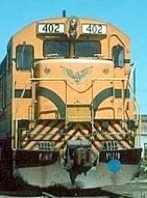The Northeast kingdom railroad

Prototype Maine Central in VT and NH
The Maine Central Railroad operated primarily in Maine, with 770 of its 850 route miles in Maine. But the Mountain Division represented an important gateway to the west. Traveling west from Portland, Maine, the 131 mile line line passed through New Hampshire's White Mountains and the legendary Crawford Notch before crossing the Connecticut River into Vermont and terminating in St. Johnsbury. The St. Johnsbury interchange allowed the MEC to ship primarily forest products to the west via the Canadian Pacific and the Canadian National (via LVRC and CV). Empties along with a few commodities would be sent back to Portland.
Train RY-2 ran once a day from Portland to St. Johnsbury, while train YR-1 ran once a day from St. Johnsbury to Portland ("R" represented "R"igby Yard in Portland, "Y" represented St. Johnsbur"y").
In New Hampshire, the Mountain Division passes through remote territory until reaching the outskirts of North Conway, some 60 miles from Portland. An interchange here in Intervale occurs with the B&M's Conway branch (Conway Scenic RR since 1974), a little bit north of the famous station in the center of North Conway. The MEC line continues along the Saco River a few miles to the small town of Bartlett (milepost 70). Bartlett at one time had a large railroad presence with a turntable and enginehouse complementing a small yard, freight and passenger depots.
The 15 mile grade from Bartlett to Crawford Notch exceeds 2%, and helpers were used to get the train over the hill. This was the reason why Bartlett featured an engine terminal in the steam days. In the 1970s however, helpers would normally leave Portland ahead of RY-2 and wait for the train at Bartlett. After helping get the train up the grade, the helpers would then cut off at Crawford station and run light back to Portland.
Last Update: July 23, 2010
Maine Central Railroad
Maine Central on my layout
Although the Maine Central is my favorite railroad and the Mountain Division is what I have always wanted to model, my layout will only partly focus on the MEC and this line. In a clinic I have given about building my layout, I mention that the Mountain Division by itself did not make for a good model railroad for my goals. There are too few industries and not enough trains. My previous layout was partially built when this realization hit me. I knew this layout needed to expand the focus or else change what I wanted to model with the Maine Central.
I decided that most of the action on the Mountain Division was from Whitefield west to St. Johnsbury. The ball signal, paper mill and activity at St. J yard worked once I expanded my design to include the CP, B&M and LVRC.
St. Johnsbury is part of phase 1 of my layout and the MEC track out of the north end of the yard past East St. J and Gilman was built in phase 2, although local track was not laid. Phase 3 saw me complete the remaining layout benchwork and this depicts Whitefield and Crawford Notch, as wee as staging for Portland.
Here are some photo scenes of the MEC as it travels from St. J to Portland staging on my layout:
More info on the Maine Central
•Book: Maine Central In Color Vol. 1, Morning Sun Books
•Book: Maine Central In Color Vol. 2, Morning Sun Books
•Book: Railroads of the Pine Tree State Vol. 1, Four Ways West, 1999
•Book: Railroads of the Pine Tree State Vol. 2, Four Ways West, 2000
•Book: New England's Colorful Railroads Vol. 1, Four Ways West, 2000
•Book: Green Mountain Rails, Robert W. Jones, 1994
•Book: Northern New England Guide To Freight and Passenger Equipment, Morning Sun Books, 1989
•Book: New England Rails 1948-1968, Morning Sun Books, 1994
•Book: Maine Central Mountain Division, Ron johnson, 470 RR Club Publication, 1986
•Book: Meet The Maine Central, 470 RR Club Publication, 1981
•The 470 Railroad Club, Monthly Newsletter, $15 year, 470rrclub.org
•"Northeast Kingdom", B & M, CV and CP Pt. 2 - February 1982 Trains, p. 22-32
•Fallen Flag: The Maine Central, Winter 2003 Classic Trains, p. 14-18
•MEC 2-8-2, June 2001 Model Railroader, p. 74
•MEC SW9, April 2000 Railroad Model Craftsman, p. 75
•MEC 2-8-0, April 1999 Model Railroader, p. 134
•Modeling MEC F3s, Nov/Dec 1999 Model Railroading, p. 20
•MEC E7, February 1998 Railroad Model Craftsman, p. 70
•MEC Wide Vision Caboose, December 1997 Railroad Model Craftsman, p. 76
•A Mill You Can Model Pt. 1 and 2, September 1997 Railmodel Journal, p. 11-25
•Northeastern Pulpwood Cars, August 1997 Railmodel Journal, p. 26-33
•MEC GP38, July 1997 Model Railroader, p. 122
•Kitbashed MEC GP7, December 1995 Railroad Model Craftsman, p. 84
•MEC Covered Hoppers, November 1995 Model Railroader, p. 110
•MEC GP7, July 1995 Model Railroader, p. 132
•MEC RS2, May 1995 Mainline Modeler, p. 35
•MEC F-Units in HO from Stewart, February 1995 Mainline Modeler, p. 58-61
•MEC 44 Tonner in HO, July 1994 Mainline Modeler, p. 70-71
•Maine Central Freight KW-1 8/3/66, January 1992 Railmodel Journal, p. 16-18 and 66-67
•Yarmouth Junction Pt. 1, May 1990 Model Railroading, p. 51-53
•Yarmouth Junction Pt. 2, June 1990 Model Railroading, p. 50-52
•Maine Central Modified Freight Cars Pt. 1, September 1989 Model Railroading, p. 10-13
•Maine Central Modified Freight Cars Pt. 2, October 1989 Model Railroading, p. 31-34
•Maine Central’s Cobbossee Branch, August 1989 Model Railroading, p. 59-64
•MEC Low Side gondola, May 1989 Railroad Model Craftsman, p. 76
•MEC RS11 Detail Close-up, May/Jun 1986 Model Railroading, p. 72
•MEC GP7 Detail Close-up, Jan/Feb 1985 Model Railroading, p. 68
•MEC Photo Roster, December 1985 Prototype Modeler, p. 33
•Crawford Notch Depot, August 1983 Railroad Model Craftsman, p. 85
•Guilford Preview, May 1983 Railfan & Railroad, p. 28-33
•Protofile: MEC 50’ Boxcar, March 1981 Railroad Model Craftsman, p. 89
•Rock Island U-Boats on the MEC, Nov/Dec 1981 Rails Northeast, p. 4-10
•MEC/B&M Ball Signal in Whitefield, October 1980 Railroad Model Craftsman, p. 83
•Mountain Subdivision, January 1950 Trains
•Video: “Todays Maine Railroads”, 105 min color, Pentrex
•Video: “Mountain Division” (filmed in 1950s), Herron Rail Services
•Railfan Site: www.angelfire.com/ct/MEC/
•Discussion site: groups.yahoo.com/group/MECRR/
•Discussion site (2nd): groups.yahoo.com/group/MEC_RR/
•Discussion site (modeling): groups.yahoo.com/group/MEC_Modeler/
Train RY-2 drifts through Bartlett, NH with 5 GP38s ready to attack the grade up to Crawford Notch.

Train YR-1 comes downgrade from Crawford Notch near Sawyers River in the late fall of October 1981.
At Crawford Notch (milepost 85), the line passed by Saco Lake and the Crawfords depot. Here an ornate station was built in the 1800s. A passing siding and other tracks facilitated any meets and the drop off/pickup of any cars for the locals. Crawfords represented the top of the extreme grade and this is where the helpers would cut off. All trains would stop to sign the train register book before continuing on. (More info and pictures are on my of Crawford Notch page)

This elevated view of Crawford Notch shows current operator of the line, the Conway Scenic RR, at the passenger station ready to depart back to North Conway.
My layout will feature the western portion of the Maine Central's Mountain Division. Starting at the CP yard in St. Johnsbury, my Maine Central line will travel east, servicing the large Georgia-Pacific paper mill in Gilman, Vt, then cross the Connecticut River and head into Whitefield, NH. At Whitefield, there will be an active interchange with the Boston & Maine RR. The diamond and ball signal will be modeled. The Mountain Division will continue east to Crawford Notch. I will include the Notch itself, the old passenger station and the passing tracks here before the line heads into staging representing Portland, Maine.






The line travelled along the Ammonoosuc River, past Fabyans and Twin Mountain before turning north to Quebec Junction (milepost 100). Quebec Junction saw the branch line to Beecher Falls divert. This line at one time went as far as Lime Ridge, Quebec, hence the name. Later the line was cut back to Beecher Falls, Vermont. Trackage rights over a portion of the B&M Berlin Branch to Groveton and then the Grand Trunk to North Stratford eliminated some redundant trackage in 1949. At North Stratford, the MEC returned to home rails for the run up past Colebrook, Stewartson and across the Connecticut River to Beecher Falls, VT, at the Canadian border. The MEC finally quit this branch in 1977 and the North Stratford RR took over operations. (See the North Stratford page for more info on this line).
Back on the Mountain Division, the line came into Whitefield (milepost 103), a neat little New England town with a very interesting track arrangement. The Boston & Maine's Berlin Branch came up from Woodsville via Littleton to meet the MEC before continuing north to Groveton, Gorham and Berlin. A diamond crossing was protected by the famous ball signal, the last operational signal of its type in the 1980s. One ball raised gave control to cross the diamond to the B&M, while 2 balls raised allowed the MEC to cross. Lanterns lit the signals at night. Trains would stop to change the signal before proceeding. Locals would set out and pick up cars on the interchange track. A couple of yard tracks, a team track and a section house completes the railroad presence in Whitefield. (See my Whitefield page for more info and pictures).
From Whitefield, the line continues west, crossing the Connecticut River and heading to Gilman, Vermont (milepost 111). Here a large paper mill represented the only substantial on-line customer on the entire Mountain Division. Locals out of St. J would service the mill on a regular basis. A passing siding and the spur into mill were located at a location known as Pages Siding. The Mountain Division trains continued on the few remaining miles along the Moose River into St. J. (More info on St. J itself can be found on my St. Johnsbury page)
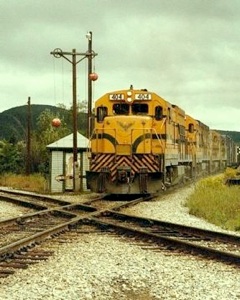
GE U18B 404 stops before crossing the diamond next to the ball signal at Whitefield, NH. The signals must be set to allow the train to cross the diamond. Photo by Doug Kroll, 1981.
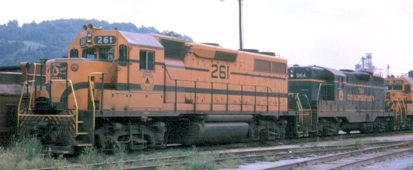
RY/YR power lays over in St. Johnsbury. The GP38s, like 261, ushered in the Harvest Gold paint, while GP7 564 wears an updated version of the Pine Tree Green scheme. In the 1970s and 80s, power for RY/YR trains usually mixed GP38s and U18Bs with the occasional GP7 or RS11 for extra power.
Operationally, RY-2s motive power would layover in St. Johnsbury and then power the YR-1 back to Portland early the next day. In the 1970s, MEC motive power primarily consisted of GP38s, augmented by the U18Bs starting in 1975. GP7s and occasionally one or both of the two RS11s would also tag along when needed. Yard switching in St. J was handled by the Canadian Pacific. An RS2 would break up the Mountain Division freight, placing CV/CN cars on one track for the Lamoille Valley RR, and Canadian Pacific cars on another track for the CP train to Newport. MEC traffic generally did not get shipped south of St. J.
The MEC did operate locals out of St. J. Six days a week, a GP7 powered local would switch cars at the paper mill in Gilman. Occasionally, this train would also continue on to Whitefield to handle the interchange with the B&M. At other times, the local to Beecher Falls operated out of St. J. There was also a time when these locals operated out of Bartlett.
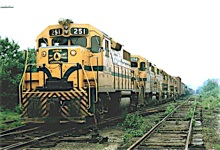
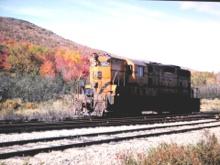
A GP7 sits on the siding at Crawford Notch. Most likely this is power for the ZO-2 local from Bartlett to Gilman which started in late 1981. It may have been cut off the RY-2 train after being used as a helper. Learn more about the MEC GP7s on my MEC GP7 page.
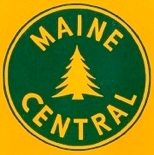


Another great picture from Glenn Salvatore’s slide collection. Here YR-1 is past the Saco River bridge and making good speed downgrade to Bartlett. GP38 257, with one ditch light out, leads the train in October 1981. Note the newer ballast, added after a series of derailments on the Mountain Division in the late 1970s.
Links to more Maine Central Pages:
(Click on map for larger view)




Leaving St. Johnsbury, the MEC track starts right in front of GP38 #261. The CP main is all the way to the right while the center track is part of the yard.
The MEC ducks under the Portland Street (Rt. 2) overpass. Here you can see how I also curved the CP track to parallel the MEC as this is on the end of the peninsula. This compromise means no duckunder of the CP track.
Next up is the area of East St. Johnsbury. I will have a Ciment Quebec facility and Maple Grove Farms as MEC customers here. Not too much has happened with this part of the layout since the track was put in. Soon though I will be adding the siding for the industries in my effort to get all track in place. The track in the front is the CP which is going downgrade. Under the MEC track is the CV staging yard which is below the MEC rack where the photo backdrop is.


Gilman is next. This may look a little confusing. The MEC main and siding are the 2 curving tracks. The tracks in the back are the St. J yard and CP main to the south. These will all be hidden behind mill buildings. I need to figure out the track layout I want here and may need to extend the benchwork out a little. Under this is staging for CP to the north, the track that was going downgrade in the previous picture. Above this scene is the deck for the North Stratford.

After curving around on hidden trackage, the MEC passes through the closet and comes out here. The track in the back is the B&M from White River Jct. Behind the wood support and the front backdrop is the CP line to the south for staging, which is hidden behind the backdrop. The roadbed in the front with no track is a spur that the MEC will serve.

This is Whitefield. The interchange tracks to the back are connecting the B&M to the MEC. The ball signal will be here. The roadbed in the front with no track is the B&M to Groveton. I will have a couple of Whitefield industries here for the B&M to serve. The MEC line meanwhile will continue behind that, somewhat hidden from view.


Here you can see the B&M passing under the MEC. No, this did not really happen, but I needed to do this on my layout in order for the B&M to get to Groveton. After the bridge the MEC will be at Crawford Notch. The mountain of foam pieces is where I will locate some industries for the B&M.
Turning 180 degrees from the last photo (on the left) you can see the small yard in Crawford Notch. The track curving at the end will pass through the Gateway, as the roadbed is carved between stone.Behind the backdrop is then Portland staging. There will be a rise in the mountains between the pink foam and the blue backdrop. This will be the first scene when visitors enter the layout room.

Here is a looking back shot where you can see the staging yard behind the backdrop, and the scenes we just covered on the right. The area right behind the backdrop here has a pop up area to get at the trains if needed.




